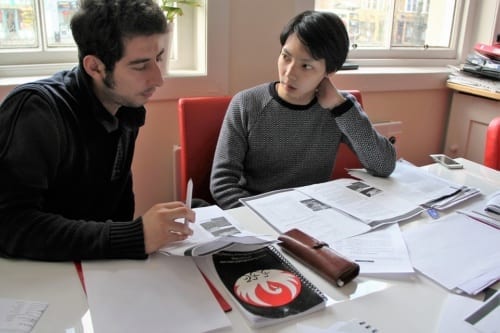Five ways to to encourage inquiry-based learning
by Matthew Howell
 A middle school student, Robert, sits nervously in his seat as his teacher comes to the closing slides in a PowerPoint presentation about the causes of the Civil War. As the final slide flashes on the screen the rumble in Robert’s stomach grows more intense. The teacher asks if anyone has any questions. No one raises his or her hand. The teacher picks up a jar of Popsicle sticks with names written on them. Sure enough she pulls Robert’s name from the bunch.
A middle school student, Robert, sits nervously in his seat as his teacher comes to the closing slides in a PowerPoint presentation about the causes of the Civil War. As the final slide flashes on the screen the rumble in Robert’s stomach grows more intense. The teacher asks if anyone has any questions. No one raises his or her hand. The teacher picks up a jar of Popsicle sticks with names written on them. Sure enough she pulls Robert’s name from the bunch.
“Robert,” the teacher calls out, “What is one of the primary reasons that the Confederacy lost the Civil War?” Robert falls silent, unable to articulate his thoughts. He shrugs his shoulders sheepishly and averts his eyes. In the pregnant pause that ensues, another student chimes in with an answer, and the discussion moves on. Robert silently lets out a gasp of stale air.
Why was Robert unable to give a response to his teacher’s question? He was attentive and interested in the topic. The list of reasons is long and varied. More importantly, does the lesson design affect Robert’s ability to understand the information?
There are ways to develop learning opportunities that meet the needs of all students, shy or outgoing, and engage the students while sparking curiosity. Below are five ways to encourage inquiry-based learning while actively including all students in a unit of study.
1.) Know What the Student Knows
 When starting a new unit of study, gather information about your student’s current knowledge base. This can be done in any number of ways. The key is to activate prior knowledge and fire-up latent understandings associated with the topic. Students can share information digitally in a shared document, on a piece of paper, or even in a drawing. They can rely on prior studies, personal experiences and memories as well as cross-curricular content.
When starting a new unit of study, gather information about your student’s current knowledge base. This can be done in any number of ways. The key is to activate prior knowledge and fire-up latent understandings associated with the topic. Students can share information digitally in a shared document, on a piece of paper, or even in a drawing. They can rely on prior studies, personal experiences and memories as well as cross-curricular content.
Then encourage students to wonder openly about the topic. Their musings will lead to questions and instill a true desire to know more. In this case, students may find themselves wondering what it was like to live in America during a time of such domestic turmoil. People learn best when they are curious. Let the student’s curiosity direct the course of the lesson.
2.) Help Learners Develop Individual Paths
When students are given the opportunity to follow their natural inquisitiveness they will follow a learning path as though it were a trail of breadcrumbs in the forest. As a teacher, you can strategically place those breadcrumbs along their learning path, especially if you know your students well. There are great tools to facilitate this process including Newsela and Mindprint Learning.
In the example of the Civil War study, some students might be most interested in the topic of social justice while others might be focused on the political construct of the day. There may be learners who are curious about the environmental or economic impacts of war, and so they will wish to study that. Students will often find interesting and important ways to conduct their own investigations with essential questions at the heart of their study.
3.) Make Time for Reflective Associations
 School days are highly structured, faced-paced, and very stimulating. The same can be said for the life of the modern learner outside the school day. This lifestyle leaves little time for open pondering (a fancy way of saying day dreaming). The intellectual space required for students to make associations between and among the vast stream of information they receive is nearly nonexistent.
School days are highly structured, faced-paced, and very stimulating. The same can be said for the life of the modern learner outside the school day. This lifestyle leaves little time for open pondering (a fancy way of saying day dreaming). The intellectual space required for students to make associations between and among the vast stream of information they receive is nearly nonexistent.
Allow students the time and space to sit in quiet stillness. Do not feel as though you need to control the outcome of this time. Encourage learners to scribble down different thoughts or ideas that arise. This process is proven to be highly valuable for those who create and explore.
4.) Design an Exit Pass
It is a simple recommendation; however, teachers should plan on gathering some information as students prepare to leave a lesson for the day. This formative assessment will allow an educator to identify gaps in understanding as well as interests that students wish to pursue further.
This is great information for the teacher to have as they consider what individualized learning tools will work best for the students as they go deeper into a unit of study. Questions and misconceptions can be a springboard for the first few minutes of the next day’s lesson.
 5.) Extend learning Through Technology
5.) Extend learning Through Technology
Student learning need not stop at the end of a lesson, nor does it need to take the shape of intensive, formulaic homework assignments. If a learner is truly curious about a topic he or she will be inspired to explore further. Conversations and observations can be shared via Google Classroom where students can post questions, seek feedback, and have conversations about content both in and out of the classroom. This format also allows students to engage with learning at a level that suites their interest and comfort level.
Incorporating this inquiry-based approach will move learning away from a call and response format to a more productive student centered approach. The students will become more engaged and excited to learn, while relinquishing doubt and negative thinking often associated “on the spot thinking.”
Author
Mr. Howell has served in the Oceanport School District since September of 2012. In addition to Oceanport School District, his 14 years in education include positions in Somerset, Ocean Township, Millstone and Hazlet. Mr. Howell’s professional experiences include classroom teaching, coaching, supervision, and administration. He has held positions at a number of age levels. Mr. Howell is passionate about education and he firmly believes that every child can succeed.
Further Reading
- eSchool News – These educators know how to make PBL work for teachers
- Education Week – The Search for Real-World STEM Problems
- Education DIVE – San Jose public school uses project-based learning to engage students


